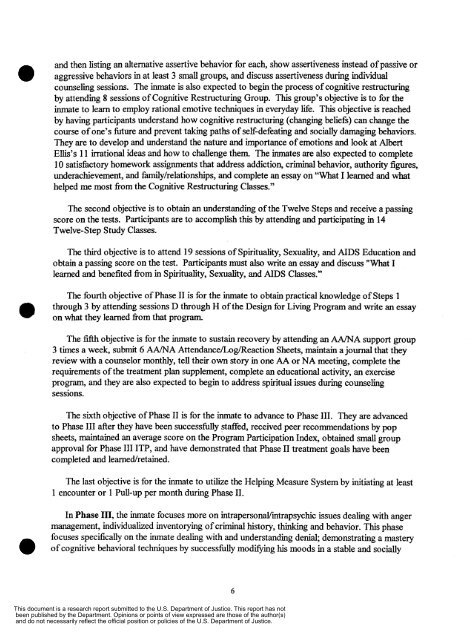0 - National Criminal Justice Reference Service
0 - National Criminal Justice Reference Service
0 - National Criminal Justice Reference Service
You also want an ePaper? Increase the reach of your titles
YUMPU automatically turns print PDFs into web optimized ePapers that Google loves.
and then listing an alternative assertive behavior for each, show assertiveness instead of passive or<br />
aggressive behaviors in at least 3 small groups, and discuss assertiveness during individual<br />
counseling sessions. The inmate is also expected to begin the process of cognitive restructuring<br />
by attending 8 sessions of Cognitive Restructuring Group. This group’s objective is to for the<br />
inmate to learn to employ rational emotive techniques in everyday life. This objective is reached<br />
by having participants understand how cognitive restructuring (changing beliefs) can change the<br />
course of one’s future and prevent taking paths of self-defeating and socially damaging behaviors.<br />
They are to develop and understand the nature and importance of emotions and look at Albert<br />
Ellis’s 11 irrational ideas and how to challenge them. The inmates are also expected to complete<br />
10 satisfactory homework assignments that address addiction, criminal behavior, authority figures,<br />
underachievement, and family/relationships, and complete an essay on “What I learned and what<br />
helped me most fiom the Cognitive Restructuring Classes.”<br />
The second objective is to obtain an understanding of the Twelve Steps and receive a passing<br />
score on the tests. Participants are to accomplish this by attending and participating in 14<br />
Twelve-Step Study Classes.<br />
The third objective is to attend 19 sessions of Spirituality, Sexuality, and AIDS Education and<br />
obtain a passing score on the test. Participants must also write an essay and discuss “What I<br />
learned and benefited fkom in Spirituality, Sexuality, and AIDS Classes.”<br />
a<br />
The fourth objective of Phase I1 is for the inmate to obtain practical knowledge of Steps 1<br />
through 3 by attending sessions D through H of the Design for Living Program and write an essay<br />
on what they learned fi-om that program.<br />
The fifth objective is for the inmate to sustain recovery by attending an M A support group<br />
3 times a week, submit 6 M A AttendanceLogReaction Sheets, maintain a journal that they<br />
review with a counselor monthly, tell their own story in one AA or NA meeting, complete the<br />
requirements of the treatment plan supplement, complete an educational activity, an exercise<br />
program, and they are also expected to begin to address spiritual issues during counseling<br />
sessions.<br />
The sixth objective of Phase I1 is for the inmate to advance to Phase 111. They are advanced<br />
to Phase I11 after they have been successfilly staffed, received peer recommendations by pop<br />
sheets, maintained an average score on the Program Participation Index, obtained small group<br />
approval for Phase 111 ITP, and have demonstrated that Phase I1 treatment goals have been<br />
completed and learnearetained.<br />
The last objective is for the inmate to utilize the Helping Measure System by initiating at least<br />
1 encounter or 1 Pull-up per month during Phase 11.<br />
In Phase 111, the inmate focuses more on intrapersonalhtrapsychic issues dealing with anger<br />
management, individualized inventorying of criminal history, thinking and behavior. This phase<br />
focuses specifically on the inmate dealing with and understanding denial; demonstrating a mastery<br />
of cognitive behavioral techniques by successfilly modifjring his moods in a stable and socially<br />
This document is a research report submitted to the U.S. Department of <strong>Justice</strong>. This report has not<br />
been published by the Department. Opinions or points of view expressed are those of the author(s)<br />
and do not necessarily reflect the official position or policies of the U.S. Department of <strong>Justice</strong>.<br />
6
















